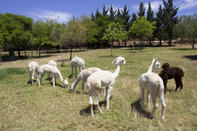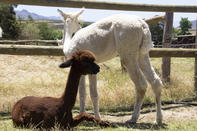In South Africa, alpacas are farmed in more temperate climates and kept on pastures where their diets may be supplemented and adapted to ensure optimal fleece quality and production.

Alpacas are semi-ruminant mammals (animals with more than one stomach) that can survive in the harsh conditions of high-altitude cold climates, and are shorn once a year.
Animals may be mated any time during the year - females are induced ovulators. It is preferable, however, that crias (baby alpacas) be born in either late summer (March - April) or in spring (October - November) rather than during winter.
Buying Alpacas
Buy the best alpacas you can afford, is the advice from alpaca farmers in South Africa. New alpaca farmers may also choose to buy SA Studbook-registered animals from other South African alpaca breeders and can spend up to R 20 000 - R 25 000 (2019) on good quality young pregnant females.
Herdsire alpacas (males to be used in a breeding program) can cost R 15 000 - 18 000 or more, estimates Dr Gavin Lindhorst, an alpaca breeder and importer. Alpacas to be used as flock guards or pets can cost much less than breeding animals.
Visit alpaca breeders to learn about alpaca breed standards, breeding history, assessing animals’ fibre and look at herdsires (breeding males) used in the herd. If wanting to build up a herd fast, start with pregnant females, advises Dr Lindhorst.
Apart from animals being imported from Chile and Peru, South Africa has also imported alpacas from Australia. Australia has acquired Peruvian bloodlines, has an active registry and show circuit which identifies superior alpacas, says Dr Lindhorst.
In addition, Australian animals have been exposed to normal livestock parasites and diseases, whereas alpacas’ natural habitat in the high Andes mountains (+3 000 m) is a sterile environment.
Farming Alpacas

Alpacas may be farmed for breeding purposes or as flock guards, but most often the ultimate objective is good fibre quantity and quality. This is determined not only by the animal’s genetics, but good nutrition and management affect how these genetics are practically utilised. For example, managing the pastures to limit fibre contamination (grasses and thorns in the fleece) around shearing time.
Alpacas are kept on pastures such as kikuyu or Eragrostis and some graze on fynbos in the Karoo. Pasture feeding can be supplemented with concentrates (grains, pellets, mineral mix, etc.) or horse meal combined with low-protein game pellets and lupin seeds.
The protein content of the diet can influence alpaca fleece quality; high protein may lead to coarsening of the fibre. It is worth noting that the alpaca has the ability to extract nutrients from the poorest grazing, but farmers are nevertheless encouraged to supplement natural grazing with additional nutrition.
It is advised to organise the farm into enough camps to be able to rotate grazing. Beware of overstocking. Various camps are also needed to accommodate the different groups such as pregnant females or yearling females, herdsires and young males, weanlings and high-care alpacas - animals that may need medicine or special nutrition.
Female alpacas (hembras) are ready to breed at 18 to 22 months and will give birth to a single cria after around 340 days. Just over two weeks after giving birth, she can be mated again. Twin alpacas are extremely rare.
Toenails and bottom teeth should be checked annually and trimmed if necessary and vaccinations are similar to those used in sheep farming. This includes protection against bluetongue virus, Rift Valley fever and Clostridia diseases.
Shearing Alpacas

Alpacas are shorn once a year, usually in springtime - September or October depending on the temperature - and can be shorn as young as six months. Similar equipment to sheep shearing is used, but a special alpaca blade is used to leave at least 4 mm of fibre on the body. Alpacas have tighter skin than sheep and must be shorn with great care to avoid injury.
The fleece from the wither (base of the neck) to the tail and around the sides of the animal is the best quality. This is called 'prime' or 'firsts'. The ‘seconds’ are the fibres on the legs and neck.
The fibre on the head and the ‘bonnet’ is shorn when it becomes too long and inhibit the alpaca’s vision but this fibre is seldom used as it is too coarse.
By Marinda Louw